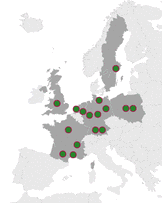What is dsd?
Most people assume that girls have girls’ genitals, female reproductive organs, female hormone levels and a female chromosome pair (XX), whereas in boys all the characteristics are typically male (testes, testosterone, XY chromosomes). Yet this is not always the case. In a number of situations some parts of the development has been typical for boys and other parts have been typical for girls. These situations are more common than most imagine, and in many cases do not involve medical interventions. The conditions are known as a Disorder / Difference or Variation of Sex Development (DSD).
DSD is an umbrella term for different conditions. They have been categorized in larger groups with similar features. The most prevalent conditions are categorized as follows:
- Conditions with an uncommon sex chromosome configuration, such as Turner syndrome, Klinefelter syndrome, mixed gonadal dysgenesis (45,X0/46,XY), and 46,XY/46,XX
- 46,XY chromosome conditions, including testicular dysgenesis (underdevelopment of the testes) and disturbances of testosterone synthesis or action.
- 46,XX chromosome conditions, including ovarian dysgenesis (underdevelopment of the ovaries), congenital adrenal hyperplasia (CAH), and non- development of the uterus or vagina.
Children who have a DSD are not all alike. There is much variation between DSDs and not all that is known about a specific DSD will be applicable to every child with that type of DSD. These are types of care that may be needed;
- Children with DSD may need hormone therapies. In some cases it may be necessary to start medication (e.g. cortisone) at birth. In other cases, hormone therapies will start at puberty.
- In later life, some children may want to have plastic genital surgery, whereas most will be satisfied with their bodies.
- Sometimes external and/or internal genitalia of your child may look different from those of other children (
 click here for a very clear and extensive brochure). These children can only after careful examination be assigned to the male or female sex. If they are raised as girls they usually experience themselves as girls; if they are raised as boys they usually experience themselves as boys.
click here for a very clear and extensive brochure). These children can only after careful examination be assigned to the male or female sex. If they are raised as girls they usually experience themselves as girls; if they are raised as boys they usually experience themselves as boys. - A very small number of children might need help in untangling their feelings about being a boy or a girl. Some of them may eventually develop an identity that is neither typically male or female (
 click here for more information.
click here for more information.
DSDs often require complex decisions relating to clinical care and other important aspects of life. Families need guidance and support in making these decisions. For instance, parents may wonder what they should tell to other people about their child before the sex assignment has taken place and the child does not have a first name yet. As soon as children are old enough they should be involved in making these decisions, but they might need more support than that their parents required.
The following websites provide an overview of these various conditions. At this website existing information on the various conditions is brought together.
![]() click here for Androgen Insensitivity Syndrome
click here for Androgen Insensitivity Syndrome
![]() click here for CAH
click here for CAH
![]() click here for testosterone synthesis deficiencies
click here for testosterone synthesis deficiencies
![]() click here for gonadal dysgenesis
click here for gonadal dysgenesis
![]() click here for Turner Syndrome
click here for Turner Syndrome
![]() click here for Klinefelter Syndrome
click here for Klinefelter Syndrome
![]() click here for 'other DSD'
click here for 'other DSD'
Information on various dsd in French, English, Spanish, German, Italian, Portuguese and Dutch:
![]() www.orpha.net/consor/cgi-bin/index.php
www.orpha.net/consor/cgi-bin/index.php
Websites with general information relating to typical and atypical sex development and DSD in general:
![]() www.aboutkidshealth.ca/en/howthebodyworks/sexdevelopmentanoverview/pages/default.aspx
www.aboutkidshealth.ca/en/howthebodyworks/sexdevelopmentanoverview/pages/default.aspx
![]() www.nhs.uk/Conditions/Disorders-Sex-Development/Pages/Introduction.aspx
www.nhs.uk/Conditions/Disorders-Sex-Development/Pages/Introduction.aspx


